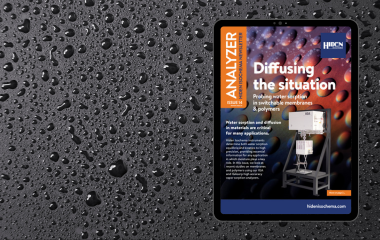What is the breakthrough curve method?
In adsorption science, breakthrough curves are a way of measuring the adsorption properties of porous materials. Porous materials are used in a number of industries as filters or separators, with one of the key applications being as ‘scrubbers’ for toxic gases like carbon monoxide for industrial waste streams.1
What happens in adsorption through a porous material is the fluid flows over the bed, which is normally arranged into a column that the fluid will pass through. As the fluid stream contacts the material of the bed, depending on the strength of the intermolecular interactions, some of the fluid will adsorb to the bed’s surface, and so not pass through the column. In chromatography applications, the adsorption process is used not to permanently trap species but to separate mixtures by changing the retention times on the column.
Recording Breakthrough Curves
Breakthrough curves measure the concentration of the adsorbate in the fluid phase at the exit of the column as a function of time. Once a breakthrough curve has been recorded, the information can be used to work not just how much loading the column can take but information on the adsorption isotherms from the interaction between the fluid and bed.2 The profile of the breakthrough curve can be used as a way of predicting the lifetime of the bed and the regeneration time too.
It is important to note that the breakthrough curve will be dependent on a number of factors in terms of how the column has been prepared, such as the packing density and column size, as well as the flow rate of the fluid as well. It is then that the breakthrough curve is recorded in similar conditions to those that will be used for operation.
Breakthrough Curve Analyzers
Examples of porous materials designed for their adsorption properties include metal-organic frameworks (MOFs) and mesoporous clays. There has been a great deal of research effort to optimize the structures and adsorption properties of these families of materials to trap specific gases, such as syngas for energy storage, and breakthrough curves are an important part of the characterization process.3
Breakthrough curves are also widely used in the separation sciences for column optimization as for the analytical sciences it is often important that the column not only separates the compounds well but does so in a reasonable timeframe.4 Breakthrough curves are one way of studying how various column preparation parameters can be optimized to achieve a good compromise between separation efficiency and run time.
What is the most effective way to record breakthrough curves? For separation sciences, there may be a mixture of products, each of which will have its own breakthrough curve due to their different retention time, making manual measurement tedious. There is also a large amount of parameter space to sample regarding flow rates, temperatures etc., for a comprehensive breakthrough curve analysis.
The answer to all of these challenges and recording breakthrough curves efficiently, effectively and in a reproducible manner are automated breakthrough analyzers. Automated breakthrough analyzers are designed specifically for the purpose of recording breakthrough curves.
By combining a mass spectrometer for product analysis with a programmable system to vary the input parameters for the breakthrough curve measurement, automated breakthrough analyzers are an ideal way of characterizing many different porous materials. Hiden Isochema’s automated breakthrough analyzers are specially designed for working with small quantities and so are ideal for performing breakthrough curve analysis on newly developed materials and optimization of their properties.
Applications
There is growing interest in using adsorption processes not just for the clean-up of toxic gases such as sulfur dioxides and carbon monoxide but also for the trapping and recycling of gases. Noble gases like krypton and xenon are now very expensive, and their chemical inertness makes them difficult to trap. However, with the use of adsorption processes in MOFs or covalent-organic-frameworks (COFs) they can be trapped, isolated and thermally desorbed later.5 Breakthrough curves can be used to optimize all stages of this process.
Contact us today to find out how automating your breakthrough curve measurements could benefit you. Hiden Isochema are experts in gas and vapor sorption technology, and our products and partnership can bring new efficiency and insights to your sorption product needs.
References and Further Reading
- Vellingiri, K., Szulejko, J. E., Kumar, P., Kwon, E. E., Kim, K. H., Deep, A., Boukhvalov, D. W., & Brown, R. J. C. (2016). Metal organic frameworks as sorption media for volatile and semi-volatile organic compounds at ambient conditions. Scientific Reports, 6(June). https://doi.org/10.1038/srep27813
- Poursaeidesfahani, A., Andres0Garcia, E., Lange, M. de, Andres-Garcia, A., Rigutto, M., Nair, N., Kapteijn, F., Gascon, J., Dubbeldam, D., & Vlugt, T. J. H. (2004). Prediction of adsorption isotherms from breakthrough curves. Microporous and Mesoporous Materials, 227, 237–244.
- Nugent, P., Giannopoulou, E. G., Burd, S. D., Elemento, O., Giannopoulou, E. G., Forrest, K., Pham, T., Ma, S., Space, B., Wojtas, L., Eddaoudi, M., & Zaworotko, M. J. (2013). Porous materials with optimal adsorption thermodynamics and kinetics for co2 separation. Nature, 495(7439), 80–84. https://doi.org/10.1038/nature11893
- Gritti, F., & Guiochon, G. (2013). Perspectives on the evolution of the column efficiency in liquid chromatography. Analytical Chemistry, 85(6), 3017–3035. https://doi.org/10.1021/ac3033307
- Liu, J., Thallapally, P. K., & Strachan, D. (2012). Metal-organic frameworks for removal of XE and KR from nuclear fuel reprocessing plants. Langmuir, 28(31), 11584–11589. https://doi.org/10.1021/la301870n


